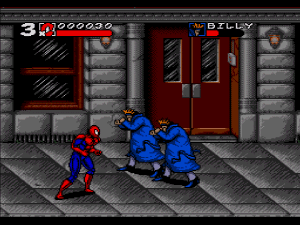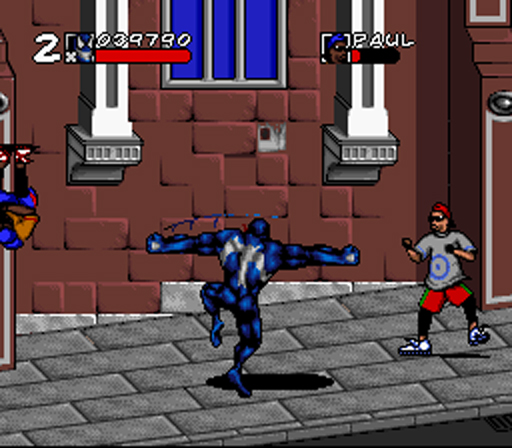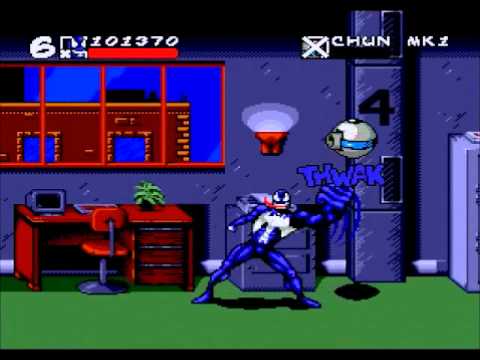Earlier this week, Sony Pictures dropped the first trailer for Venom: Let There be Carnage, the sequel to 2018’s Venom that, hopefully, will arrive in theaters this September.
This will mark the live-action debut for the scarlet symbiote, but for many – myself included – they got their introduction to the character through the beat ’em up Spider-Man/Venom: Maximum Carnage, easily one of the best comic book games of the 16-bit era that is still a blast to play even today.
Released in 1994 and based off of the comic book event of the same name, Maximum Carnage stood out in crowded market of competitors with its unforgettable soundtrack and between stage cut-sequences that actually used panels from the comics. Even today, it stands as one of the rare titles based off of a comic book that tries its hand at adapting a story into the digital medium.
I reached out to Chun Wah Kong, an exceptionally talented veteran of the video game industry who worked on the red cartridge classic via e-mail to talk about the game’s creation. Chun is still active in the industry today, producing retro style games like Millie and Molly for the C64, a title that was voted game of the year by Retro Video Game in 2020.
You can follow Chun on his Instagram page.
CBVG: You talked about how you joined the Spider-Man/Venom: Maximum Carnage team in the second volume of the SNES Omnibus, but for those unfamiliar, what’s your Maximum Carnage origin story as it were? How did you find yourself working on the game?
CHUN WAH KONG: A friend suggested I go for a job at Software Creations testing games when I had nothing else better to do after I failed to get into uni. I was going to do that for a bit as a stop gap before reapplying the following year. In the first few months, I playtested some amazing games like Plok!, Equinox and Spider-Man and the X-Men in Arcade’s Revenge. One day, Rick, the managing director came downstairs and asked if I wanted to help on this new Spider-Man beat ‘em up game. He knew I loved playing Double Dragon, Final Fight and all those games. Software Creations was a smallish company and everyone did what they had to. From here I was setup with a PC with the game code and shown how the level data works.
CBVG: Maximum Carnage is inspired by a fourteen-issue crossover event. When designing levels, how beholden were you to the stories’ structure?
KONG: The main structure of the game, as in how the story divided into levels was pretty much decided when I joined. I would imagine our producer worked with Acclaim to agree on a list of comic book cut scenes that would drive the story, and action sequences that would be exciting to present as gameplay. My job then was to take all the assets; the game mechanics, the features, and spread them over this structure. I’d be lying if I sit here today and say it was done in a methodical manner because it wasn’t. I would say beyond the key points in the narrative, we were given plenty of creative freedom. I certainly didn’t study the comic to see if there were any trench coat baddies in specific areas before putting them in.
CBVG: After Sega’s 1991 arcade game, this was the second real attempt to bring Spider-Man into the beat ‘em up genre. How did the character’s abilities – wall-crawling, web-swinging – factor into designing levels? For example, there are spare lives and power-ups for those who climb walls looking for them. Were they intentionally placed up high for intrepid explorers?
KONG: We were very conscious Spider-Man and Venom had all these signature moves, but there weren’t many instances outside of the levels Climb and Chase where they categorically have to utilize these abilities in order to win. Even though some of the level maps were limited in size, I started placing bonuses higher up and in difficult to get to places to entice the player to wall-climb and web-swing. In a way, this plays like a little optional mini-game between the combat. The player would defeat all the baddies in a zone and then collect all the bonuses before they move onto the next.
CBVG: Once the levels were built, describe the process of populating them with the enemies and designing their quirks and behaviors. Where did the likes of the hair-whipping female baddies and the umbrella toting businessmen come from?
KONG: If I remember correctly, our artists came up with the designs for the generic baddies. I can only assume they wanted to capture the diversity of New York City that’s why you’ve got everyone from b-boys to businessmen. At one stage they wanted to get more variety by mixing and matching heads with different bodies, but I think we ended up only applying this idea to the prison guards in the Police Station level. Thinking back, it was pretty amazing how many different characters we managed to squeeze into a 16mb cartridge game.
For the most common level types where the level scrolls from one end to the other, I would plan how many zones there are and their parameters so the player can’t just run through them without fighting anyone. In each zone I managed the maximum number of baddies there can be at any given time, who they are and where they appear from. Once they are cleared then it’s onto the next.
The baddies’ behaviors were governed by logic tables which constantly assessed the actions and distance of the player character. To put it simply, if Spider-Man is throwing punches 3 meters away, I would instruct a dumber baddy to approach, whereas a smarter one should try and walk around. Now expand this concept and apply it to all of the player characters’ moves, at different distances and with the addition of alternate reactions if the player used the same move repeatedly. This way, the baddies won’t always behave the same.
The logic tables were very flexible and offered me plenty of scope to create a wide ranging set of interesting behaviors, and the variety of characters made sure there were always something new right to the end of the game.
CBVG: Much like the Maximum Carnage story, Carnage’s followers like Doppleganger, Shriek, and Demogoblin become constant thorns in your side. How different was it crafting their attack patterns compared to those of the regular thugs you come up against?
KONG: Not that different to be honest, the principles were pretty much the same. What was different is that with every boss fight, we knew exactly which characters were going to be on the screen so I could tailor their behaviours according to the level and which other supervillains I know would be there with them. Despite this capability, I think I could have done a better job with their difficulty curve. I made the super villains rather hardcore as I didn’t have the wisdom to consider the wider gaming audience who might not be experts in this genre but are Marvel fans.
CBVG: There are a lot of boss rush sections towards the end of Maximum Carnage. Was this something that was done to fall more in line with the story in the comics?
KONG: I would think so and by that stage we had introduced more of the superheroes (the dev team used to call them “cameos”). On a similar train of thought as the wall-climb and web-swing, I felt it should be a necessity for the player to call upon these cameo superheroes, so in the latter stages I made the supervillain bosses extra difficult to defeat with Spider-Man and Venom alone. I think this is one aspect why even seasoned gamers found Maximum Carnage challenging if they didn’t adopt this approach.
CBVG: Perhaps one of Maximum Carnage’s best features is its branching path sequences where you can choose to be Spider-Man or Venom with each getting their own unique stages. Was it challenging thinking up different stages for each hero, and do you have a preference in who you picked? How much input did you have into the individual feel of each character?
KONG: I wish I could have made Spider-Man and Venom play more differently than they do, instead, I went with the fast-but-weak and slow-but-strong clichés. Sometimes I wish I still have the code so I can redo the logic for the entire game. I personally find Spidey’s branching levels easier than Venom’s, but you are rewarded for picking Venom because his moves look cooler and you’ve got the only slopey level in the entire game with San Francisco. Statue of Liberty secret level and how that is triggered is pretty sweet too. I guess that’s one of the risk and rewards in the game.
CBVG: Was there ever a point in the design process where Spider-Man and Venom would’ve been stuck closer together so you could play Maximum Carnage with a friend?
KONG: I believe any notion of that was set aside early on in favour of the ability to switch between characters at key story points in the game. I think it was the right decision and it offered the game another unique feature that you don’t normally see in this genre. As a greenhand in level building, it would have been a much steeper learning curve to do the logic tables for a 2 player simultaneous game any justice; I know this as I did some for Venom/Spider-Man: Separation Anxiety.
CBVG: With the aid of items you can find in the environment, you can summon characters like Cloak, Dagger, Firestar and Captain America, all characters who appears in the comic story, to help you. The way in which they’re rolled out, it’s almost like how they appear in the game similar to how they show up in Maximum Carnage story. Was this the case?
KONG: Yes. We created a list of where each cameo superhero can appear according to the comic story. I hope we got it right. If not then I’ll put it down to creative freedom.
CBVG: Iron First will heal you if you’re using Spider-Man, or attack if the player is controlling Venom. Was there much development time used in programming two different uses for a power-up like this?
KONG: The general idea is that the cameos are more attack minded when they are with Venom than Spidey. Also, the player has to learn the effectiveness of each superhero against the supervillains. When you break down every aspect of the game, there really is a substantial amount of strategy involved.
CBVG: In the seventh chapter of Maximum Carnage, a brief stop is made to the Baxter Building, the home of the Fantastic Four, to collect a weapon to fight Carnage. In one panel, you can see a circular robot on the ground, and in the game, you’re bombarded by similar looking machines from the “Chun” line. Talk about how they got their name, how they came to be, and where the Muzzoid boss idea came from.
KONG: I remember the discussion regarding these levels and how we could make them fun. We were always juggling between creativity, resource and technical constraints. We decided on a version of floating droids as they would require no additional frames of animations. We also introduced the energy fields which tested the player on their timing. If I remember correctly, there is a trick where if you time it correctly, you can just run through it all from start to finish. Muzzoid was a tribute to games like Gunstar Heroes where bosses have modular parts in their construction. Everyone in the office got a character in the game named after them, at the time I couldn’t think of a better name for the droids but my own name so I put that in and it just stuck. Muzzoid was named after the lead programmer Paul Murray.
CBVG: A big help in getting to the end of Maximum Carnage is collecting precious lives from its many secret rooms. Getting to them without outside help, however, can be extremely tricky. Where did the idea of the secret rooms come from, and did you ever consider guiding the player to them more organically, or were they always meant to be hard to discover?
KONG: We wanted there to be many Easter eggs in the game for the player to discover. The secret rooms only took up very little memory so I tried to put as many of them in as possible. There were a good mixture of ones that the player was likely to trigger by accident, and ones which were well hidden and I guess need to be revealed through magazines and strategy guides. I guess they extended the longevity of the game and got kids in the playground talking. The one that comes to mind is the backflip onto the skylight in the Manhattan Rooftop level. I’ve seen so many people discover that by chance and gave a really positive response to it. Once they find one they want to know if there are more. I also remember holding back on several secret rooms from the official strategy guide, but over time I have forgotten how to access them myself. Maybe they have been lost forever.
CBVG: Finally, is there something that you would like to say to lovers of Maximum Carnage both old and new, and do you have any tips on how to go about toppling the titular red menace?
KONG: I’d like to thank all the fans of Maximum Carnage, they are all very passionate. I was only 18 then and I worked in a team of talented developers. My boss gave me the opportunity which I am forever grateful. We never received much first hand feedback from the gamers, only magazine reviews and those were a mixed bag. So reading about people’s childhood stories now of them renting the game multiple times back in the day so they could complete it is heart warming.
From what I can remember, I use a combination of 2 strategies against Carnage on the last level. I find an opening to get up close to knock him back with a quick combo. Before he can recover, quickly close the distance with a shoulder charge and repeat. Mix this up and exploit the brief moment of invincibility when you tag the other character in. Venom is the stronger character so try and land your telling blows with him. I hope I’ve got that right, I haven’t played the game in years. Maybe I should fire it up for the memories.







Pingback: CELEBRATING 10 YEARS OF COMIC BOOK VIDEO GAMES | Comic Book Video Games